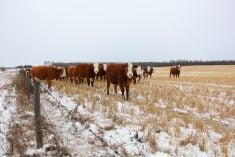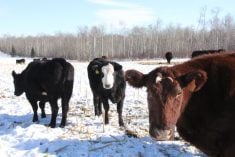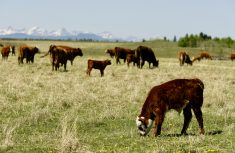Make sure cows are at their optimum body condition score at calving and keep it going for the rest of the year
If your spring-calving beef herd is on the thin side, now is the time to get them back into proper condition before calving season, says a long-time western Canadian livestock nutritionist.
Cows in less-than-optimum body condition at calving will not only raise calves with poor performance but it also increases the risk of the cows themselves having poor reproductive performance during breeding season, says Barry Yaremcio, owner of Yaremcio Ag Consulting at Camrose, Alta.
“If cows are thin at calving, it is too late to make up for it then. Producers need to be providing their pregnant cows with a well-balanced ration during the third trimester of their pregnancy.”
Read Also

Canadian Beef Check-Off Agency reports on investments and activities
The check-off agency’s work behind the scenes is what ensures cattle check-off dollars are invested wisely, accounted for transparently and deliver measurable value back to producers and importers.
Yaremcio says with farms and ranches in many areas of Western Canada experiencing poor growing season conditions in 2024, they are heading into winter with poorer feed quality and perhaps reduced quantity. That could mean cows in some herds are thinner than they should be.
Body condition score
“For optimum performance beef cattle should be in the three to 3.5 body condition score range at calving,” he says.
Condition scores range from one (a very thin cow with no fat reserves) to five (a severely over-conditioned cow). For information on what cattle with these scores look like or how to perform condition scoring, one excellent source is to visit the Beef Cattle Research Council website at beefresearch.ca.
Yaremcio says having thin cows at calving sets in motion a whole sequence of poor performance issues for cows and calves that are either going to mean lost income or added expenses to try to correct down the road.

Yaremcio points to these top three issues:
Thinner cows cost more to maintain. If a cow is 200 pounds lighter than her optimum body condition, for example, that animal has less fat, and less insulation so over winter she will require about 1,400 more pounds of hay just to stay warm compared to cattle in the more optimal three to 3.5 body condition score range. That’s 1,400 pounds of hay over and above the regular ration.
Thinner cows are not going to produce the quality and quantity of colostrum that newborn calves require. That will affect the amount of passive disease immunity the mother can pass along to her calf.
The peak lactation period for a cow occurs eight weeks after calving and the peak feed intake by her calf occurs 12 weeks after calving. If that cow is thin or under-conditioned to begin with, to meet that demand for extra energy to produce milk she will draw down her fat reserves, further reducing her condition. Newborn calves need to consume about seven pounds of milk to achieve one pound of gain. If a thin cow’s milk production is even two pounds less per day that shortfall will persist throughout her whole lactation, and it means her calf will have reduced growth.
Yaremcio says in preparation for the 2025 spring calving season, producers need to first assess the body condition score of their herd, and then have a close look at the feed ration during the third trimester of gestation to ensure they are providing a well-balanced ration that meets the needs of the cow as well as the unborn calf.
He says the ration during the third trimester needs to provide the cow with nine per cent protein and 60 per cent total digestible nutrients daily.
“That recommendation is a bit higher than National Research Council and CowBytes (ration balancing software) recommendations. But I believe it better reflects nutritional needs of cattle under western Canadian winter weather conditions.”
The higher protein is needed to maintain optimum microbial populations and activity in the rumen so they can digest fibre properly. If an animal is short on protein it takes longer to digest fibre and reduces feed intake.
Test feed and water
To determine the starting point of a balanced ration, Yaremcio says it is important to obtain both a feed test and drinking water analysis.
“I won’t even formulate a ration unless we also have a water analysis. Water quality can be all over the board, especially with components such as sulphur and sodium. To formulate a properly balanced feed ration, I also need to know water quality.”
The most recent Western Canadian Cow-Calf Survey shows that about 70 per cent of producers do have feed tested, but only about 40 per cent of farms have water tested.

Yaremcio says the feed analysis should also include a test for trace minerals such as copper, manganese and zinc.
“You also want to include molybdenum and sulphur in the test because at higher levels they can tie up copper. Research by Dr. Cheryl Waldner at the Western College of Veterinary Medicine shows that copper requirements are higher than previously thought. Many feeds can be deficient and copper has a direct effect on the ability of the cow to recycle and rebreed after calving.”
Again, the BCRC website is an excellent resource for advice on how to collect a proper feed sample for analysis. The cost of feed testing and water analysis can vary widely depending on the lab and the degree of testing to be done. Feed tests in Canada can range from $30 to $150, while water testing ranges from $50 to $200.
If producers feel confident, they can use feed tests and water analysis to formulate a ration. CowBytes software is a very useful tool. As well, some provinces still have provincial livestock specialists who can provide advice, local feed companies have livestock nutritionists and producers can also contact independent livestock nutritionists for help in formulating a ration.
Vitamins and minerals
Producers also need to pay close attention to mineral supplementation, particularly during the third trimester, says Yaremcio.
“The cow is developing colostrum and the fetus is growing at a rate of three-quarters to one pound per day. So the cow needs to be provided with both the micronutrients and vitamins needed to keep her whole system primed so it is ready to go when that calf is born.”
If producers are feeding a cereal crop — greenfeed or swath grazing — there is a good chance the feed will be deficient in calcium and manganese. The mineral mix should also have sufficient levels of trace minerals such as copper, manganese, cobalt and iodine, to name a few.
And don’t forget about vitamins. A well-formulated mineral mix for that third trimester should also include vitamins A, E and D. It is recommended beef cows have a minimum daily intake of 300 IU of vitamin E, 40,000 to 60,000 IU of vitamin A, and 4,400 to 6,600 IU of vitamin D.
“Read the labels to make sure the mineral blend has sufficient ingredients. Vitamin E is the most expensive. It may be on the label but not at sufficient levels to meet a cow’s requirements, so don’t just assume everything is covered.”
A couple of tips about feeding mineral and vitamin mixes — most mineral mixes have sufficient salt included, so separate salt blocks are not needed, says Yaremcio. It is common practice to place mineral tubs near water sources. However, University of Nebraska-Lincoln research showed cattle consumed the most mineral at night when tubs or mineral feeders were placed in the loafing area or where cattle commonly bed down.
As a rule of thumb, cattle should be consuming about 100 grams of minerals and vitamin mixes per head per day, so a 50-pound bag of mineral mix should be sufficient for 250 head of cattle. If they are not consuming enough, Yaremcio suggests adding five pounds of dried molasses to the tub and if they are consuming too much, then add a bit more salt.
“Pay attention and keep adjusting the amount of molasses or salt as needed until you achieve the proper daily intake.”
Molasses lick tubes are a popular way to provide supplements to the beef herd, but again, Yaremcio urges producers to read the label to know what nutrients are being provided. The tag may show the tub supplies calcium and phosphorus, for example, but it may be at only a three per cent level rather than the 15 to 20 per cent level that’s needed. And the protein in lick tubs can range from 16 to 30 per cent but often it is in the form of a non-protein nitrogen such as urea. Cattle may need to be supplied with grain to improve protein utilization.
Cows with an ideal body condition score re-breed up to 30 days sooner than thin cows, which allows more cows to calve in the first 21-day cycle. This can add up to 42 pounds in calf weaning weight since the calves born earlier in the calving season will be heavier at weaning time.
Cows in ideal body condition also have pregnancy rates double those of cows in poor condition, have improved milk production, fewer cases of abortion and stillbirth, healthier calves, and fewer instances of calving problems.
“Making sure your cattle are in optimum body condition at calving will improve the performance of her calf, but also benefit her long-term performance in the herd. We don’t want to see cows losing weight or condition between calving and breeding. A proper (body condition score) at calving is important, but producers need to remember that providing proper nutrition to the herd is a year-round endeavour.”
– Lee Hart is a long-time agricultural writer based in Calgary. Contact him at 403-815- 3719 or by email at [email protected]

















